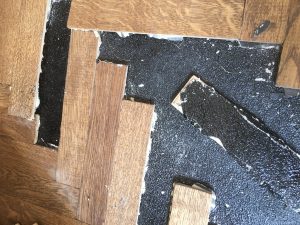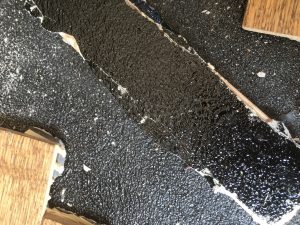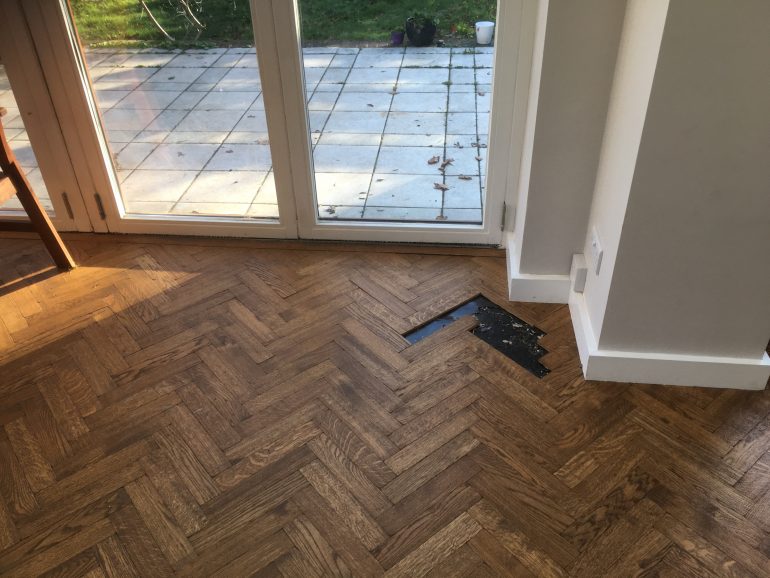This month, Simon Jenkins, who covers the North London area, talks about a ground floor residential installation that failed because of an improper moisture management solution.
“I recently provided support to a flooring contractor who had been called to a Victorian residential property where timber flooring had been installed in a ground floor extension, and the wood had begun to warp and lift – it looked like waves on the sea.
Damp seemed the obvious cause – it’s still the leading cause of floor failure. Where subfloor relative humidity levels are above 75% (65% where wood floorcoverings will be installed), a moisture management solution is absolutely essential to stop moisture attacking floorcoverings and adhesives.

Closer inspection
To be sure, we lifted some of the floorcoverings to inspect the subfloor. The builder who had undertaken the preparation work had applied a waterproof surface membrane over the newly-installed concrete screed, followed by a thin layer of levelling compound to create a smooth base for floorcoverings. The age of the property meant that there would have been no legal requirement for a damp-proof course to be installed when it was built.
So the problem couldn’t be damp? Well, I suspected that the solution in place was actually a bitumen damp-proof membrane. When we got in touch with the builder to check, this was confirmed.
The issue
The problem is that these types of waterproof surface membrane, unlike epoxy/resin systems, such as F. Ball’s Stopgap F77, or water-based types, such as Stopgap F78, don’t form a rigid film when cured. Instead they remain soft and flexible. This isn’t an issue if a thick, structural screed is applied over the top. However, if a thin layer of levelling compound is applied, the stresses that the bitumen damp-proof membrane (DPM) will be subject to can cause it to separate, compromising its integrity and allowing subfloor moisture to migrate to the level of floorcoverings and cause problems.

The solution
In this situation, there was no other option but to lift all of the floorcoverings and mechanically remove the previously installed levelling compound and bitumen DPM. The flooring contractors who sought our guidance could then use F. Ball products to install new wood floorcoverings.
Following this, they applied F. Ball’s Stopgap F77, which creates a barrier against excess subfloor moisture where subfloor relative humidity levels are up to 98% with a single coat application.
Reinstalling the base
Once the membrane had cured, the surface was primed using Stopgap P141. This is specially formulated to enhance the bond performance between non-absorbent surfaces, including waterproof surface membranes, and levelling compounds applied next. It contains recycled uPVC pulver to create a textured finish, which helps adhesion.
To create the perfect base for the new wood floorcoverings, we recommended that contractors applied Stopgap 300 HD heavy duty levelling compound.Its compressive strength creates a durable surface, which is important if floors are going to be subject to heavy loads or high levels of foot traffic. Its excellent self-levelling properties ensure a completely smooth base for floorcoverings.

Full circle
Finally, the contractors used Styccobond B95, a flexible wood adhesive, to install new wooden blocks in a herringbone pattern. This is a single-part, moisture curing adhesive that will accommodate the natural movement of wood throughout the lifetime of the installation. It also offers good initial grab, useful for creating the parquet design.
Using these products in this order will ensure a long lasting professional flooring finish, with no risk of floor failure as the result of excess subfloor moisture this time.”
Simon Jenkins is F. Ball technical representative for North London
F. Ball’s regional technical representatives provide advice to flooring contractors on how to get the most out of F. Ball products, including conducting site visits and producing case-specific reports advising on the best course of action for particular flooring projects. Find out who your technical representative is here.


